- NLI Research Institute >
- Major Home Builders Confront a Shrinking Market
Major Home Builders Confront a Shrinking Market
Michio Murakoso
Font size
- S
- M
- L
The major home builders enjoyed consistent growth before and after the bubble economy led by the detached single-family home market segment. Against a backdrop of declining multi-family homes since fiscal 1992, all major home builders have shifted their management resources and focused on detached houses. Strong demand for detached houses was also supported by reconstruction demand in fiscal 1995 following the Hanshin Earthquake, and by the demand rush in fiscal 1996 ahead of the consumption tax hike.
But in fiscal 1997, the industry's robust growth has ended with the first significant decline in orders in the post-bubble era. At the beginning of the fiscal year, companies had forecast sustained growth in earnings and sales growth; by mid year, the outlook had deteriorated to a single-digit decline in sales and a 30 percent earnings drop at best. The major reason for this dismal performance has been the unexpected decline in detached homes, the main engine of growth.
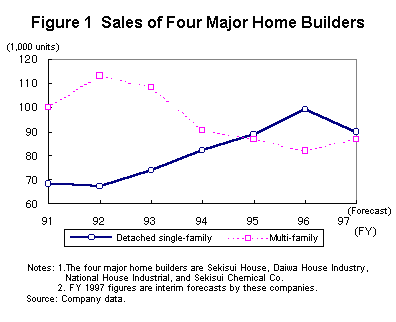
2. Made-to-Order Sales Dominate the Detached Single-family Home Market
A salient feature of Japan's detached single-family home market is the predominance of new and made-to-order homes. In the U.S. market, there is a well established secondary market for existing homes that forms the core of the home market, with built-for-sale housing comprising the bulk of the new home market. In contrast, the secondary market for Japan's detached single-family home market is underdeveloped, while new homes are primarily made to order. In the new home market for detached homes, built-for-sale homes account for less than 20 percent, and made-to-order homes 80 percent of the total market.
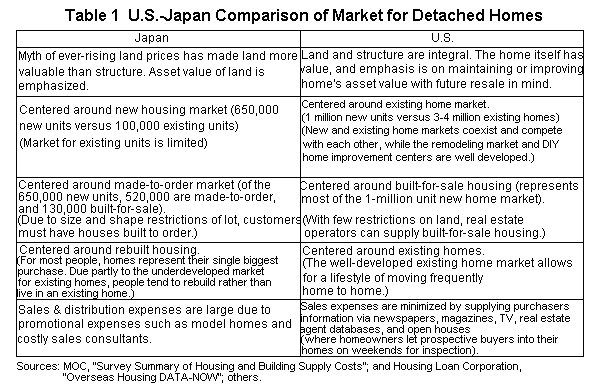
(2) Stable Volume, Steady Growth in Quality
While the made-to-order market for detached single-family homes is not growing, it remains stable (since most housing starts are for made-to-order detached homes, below we treat owned-home data as identical to data for made-to-order homes). Amid significant fluctuations in the overall housing market caused by economic and interest rate trends, the made-to-order housing market has been the most stable market segment with approximately 600,000 units in annual volume.
In addition, the made-to-order market has seen home prices rising consistently against the backdrop of a strong demand for quality enhancements. The demand for quality is symbolized by the steady growth in average floor space of made-to-order homes. In contrast, although rental apartments have grown bigger and smaller over time, there has not been any significant net change in their average floor space.
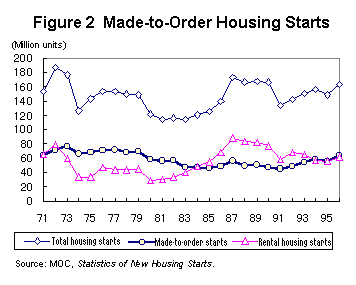
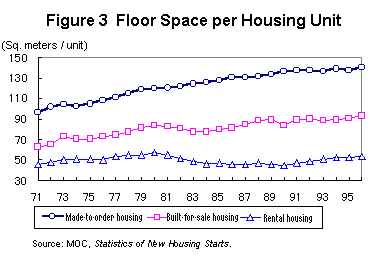
3. Major Home Builders' Strategy for Detached Homes
(1) Growth Strategies Based on Price and Volume
Major home builders have developed two growth strategies for the detached home market. The first strategy is to raise home prices by offering higher quality. With one household per dwelling and land prices falling, consumers are seeking higher quality. Major home builders have raised home prices by offering larger homes and more value added.
The second strategy is to expand volume by acquiring market share. The majority of detached homes are supplied by small, mid-sized, and second-tier builders. Since the market itself is not growing, major home builders are trying to win market share away from smaller builders. The potential gains are sizable, since even Sekisui House, the largest home builder, holds less than a 5 percent market share.
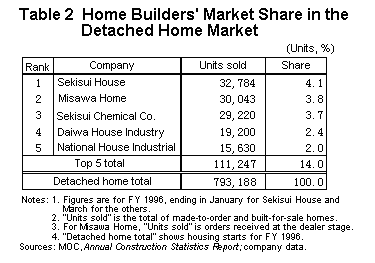
(2) Specializing in High Quality Made-to-Order Homes for Second-time Buyers
There are three characteristics to the price-based growth strategy of major home builders. First, they have specialized in the made-to-order segment of the detached home market, building homes for individual owners and limiting their involvement in built-for-sale housing and the land parceling it involves.
Second, their products are centered around high-quality homes. Despite slight differences, the major home builders generally offer high quality and performance. Consumers are willing to pay the high prices because of the higher quality and reputation. The average unit price of prefabricated homes, a segment dominated by major home builders, has been consistently higher than of conventional wood frame houses built by second-tier builders.
Third, their primary customer segment consists of second-time buyers who are mostly salaried workers in their forties and want to rebuild their homes. Rebuilt homes account for approximately 50 percent of the homes built by major home builders, compared to an average of 30 percent for the market. Financing is easy to arrange because it is limited to the rebuilding cost, and because middle-aged salarymen have a dependable future income. These customers can generally afford to build an expensive home.
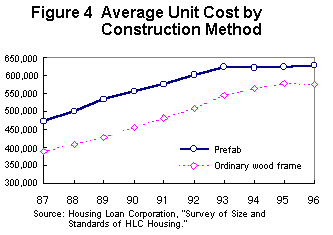
(3) Sales Using Model Homes and Sales Consultants
One characteristic of the growth strategy based on volume is that sales activity consists of setting up exhibits of lavishly built model homes to attract potential customers. Second, specialized sales consultants are hired to help identify and fulfill customers' needs. This compares favorably to the sales activities of small and mid-sized builders, who specialize in a particular geographical area, and depend on personal and local ties instead of special facilities and personnel.
Sales consultants provide customers a wide variety of services related to home building. In addition to product information, they provide consulting services in designing floor plans, arranging financing, assuring compliance with construction laws and regulations, and handling tax matters. The valuable role played by sales consultants underlies the powerful sales capabilities of major home builders that differentiate them from small and mid-sized builders.
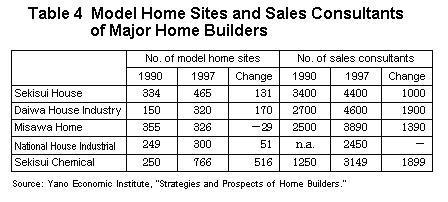
4. Regimented Marketing and High Business Costs
(1) Limits of Regimented Marketing
Recently, the major home builders have been struggling with an unprecedented decline in demand. While the main cause can be attributed to a demand-side slump in consumer confidence, a contributing factor has been the homogeneous and regimented marketing activities on the supply side. Despite greater diversity in residential demand, there has been a prevailing sameness among home builders in their housing concepts and business methods. Their common marketing strategy is to sell high-quality, high-priced homes using sophisticated but costly sales consultants and somewhat unrealistic and extravagant model homes.
A change in demand for the products of major home builders appeared as early as 1995. Prefabricated housing prices, which had consistently risen since before the bubble period, declined for the first time that year. In addition to income factors, this can be attributed to a shift in consumer priorities from quality and performance to cost-performance. The threesome of high-priced products, model homes, and sales consultants may still be effective among customers with high incomes. But the limits of the higher-value-added approach have become apparent.
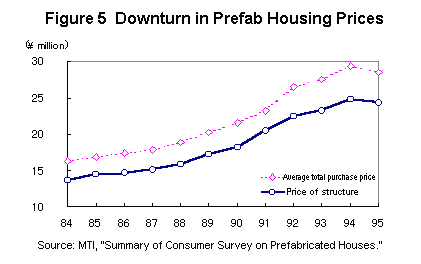
(2) Rising Sales and Administrative Costs
The substantial downward revision in sales and earnings forecasts this year has revealed a cost structure bogged down by large operating costs. While the aggressive expansion in capacity has led to sales growth, high sales and administrative costs have introduced a downside risk.
Operating costs have been rising consistently among the major home builders. This is because high earnings had been used not only on advertising expenses but invested to expand sales capacity. While capital investment in production plants has been limited, what has risen are administrative costs at the main office and sales infrastructure costs from setting up model home exhibits and hiring sales consultants. Due to the lack of product differentiation among home builders, sales volume was largely determined by sales power, which in practice was proportional to the number of model home exhibits and sales consultants.
Rising operating costs were not a problem as long as they could be absorbed by higher sales volume and prices. However, once the volume stops growing, the high cost structure becomes painfully apparent.
5. Reconsidering Business Strategies
(1) Generating Demand and Attempting Restructuring
Faced with a shrinking market, the major home builders are resorting to new ways to stimulate demand, such as introducing new products and developing new sales channels. New products include standardized low-cost products for first-time buyers and three-story houses. As for sales channels, they are experimenting with alternatives to model home exhibits, such as opening showrooms and putting more strength in orders from corporate customers.
Behind the desperate measures to keep business from contracting are the rising fixed costs in profit structures. In terms of hardware, home builders not only have the capacity to process and produce building supplies and materials, but to undertake the actual construction of homes. On the software side, they have the combined capacity to plan and develop products, and to design and sell them through consultants. Home builders need to have all of these capacities. However, in the past few years, the fixed costs associated with maintaining these diverse functions has ballooned, causing home builders to change toward a profit structure similar to installation firms. This is due to a diverse business infrastructure including building supply factors and cooperating plants to undertake manufacturing function, construction division or cooperating company for the construction function, a product development division or housing research institute for the product development function, and model home exhibits, design division, sales consultants for the consulting business.
If sufficient sales cannot be maintained, the infrastructure underlying these functions must be restructured. One major home builder has already announced a 20 percent reduction in model home exhibits by March 1999.
(2) From Flow Value to Stock Value
In the longer term, the major home builders will be counted on to provide consumers diverse information related to the accumulated housing stock, propose housing concepts suited to the 21st century, and lead the housing market as a key component of domestic demand.
Specifically, they will need to adapt their business to an era that will build housing stock by developing new product concepts and diversifying sales channels.
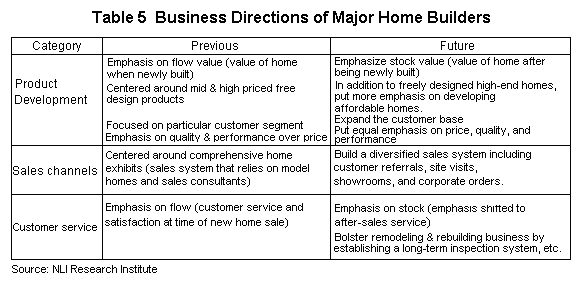
Product development will shift in emphasis from flow to stock considerations. The greatest problem with made-to-order homes is their low resale value. Homes need to be developed that can maintain their value in resale. In addition, the present lineup of products centered around high-priced homes must be reconsidered.
In diversifying sales channels, innovations will be needed in sales channels and methods to shift the emphasis from quality to cost-performance. For major home builders with established reputations for high quality and performance, the keyword will be price competitiveness.
This entails not merely offering a wider selection of low-end products, but cutting costs throughout the production and supply system, including sales methods. Homes of high quality and performance will need to be supplied at lower cost.
Third, customer satisfaction (CS) will shift in emphasis from flow to stock. Initiatives that have been implemented in this direction include long-term home inspection systems and after-sales service divisions. In the coming era of stock, the remodeling and existing home markets are expected to see full-fledged development. Moreover, home builders need to look ahead and expand beyond these core business areas and develop a "comprehensive residential life industry" that encompasses related services such as welfare, medical care, information technology, and education.
Japan's housing market has moved beyond a growth period based on volume and now stands at the threshold of a growth period based on quality. And as the next century approaches, the industry now urgently needs to shift its concept of quality-based growth from one centered around flow to one centered around stock.
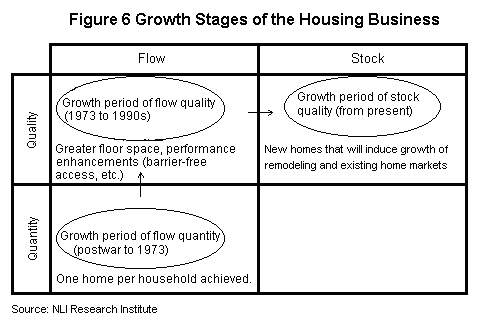
Michio Murakoso
Research field
レポート紹介
-
研究領域
-
経済
-
金融・為替
-
資産運用・資産形成
-
年金
-
社会保障制度
-
保険
-
不動産
-
経営・ビジネス
-
暮らし
-
ジェロントロジー(高齢社会総合研究)
-
医療・介護・健康・ヘルスケア
-
政策提言
-
-
注目テーマ・キーワード
-
統計・指標・重要イベント
-
媒体
- アクセスランキング

















